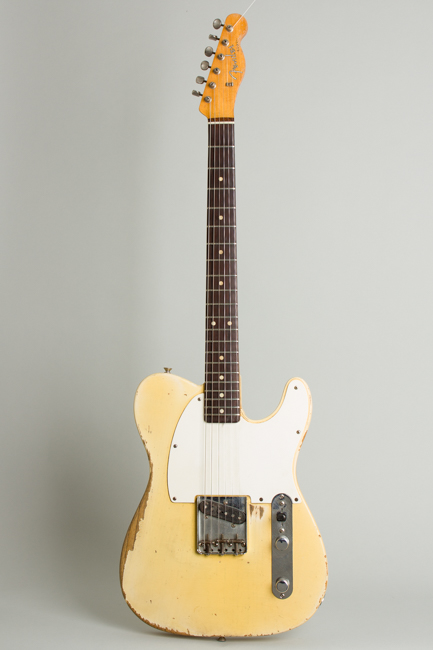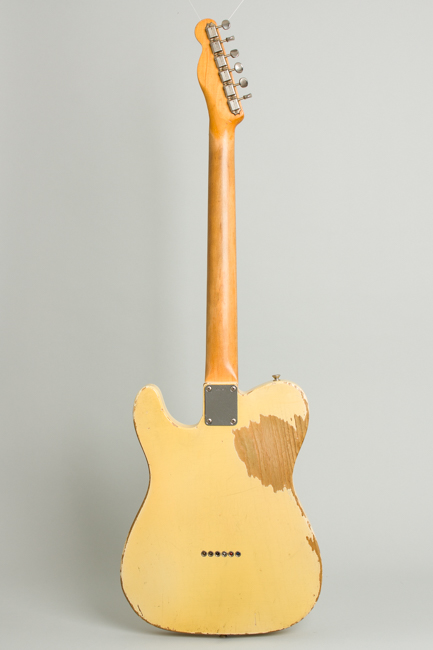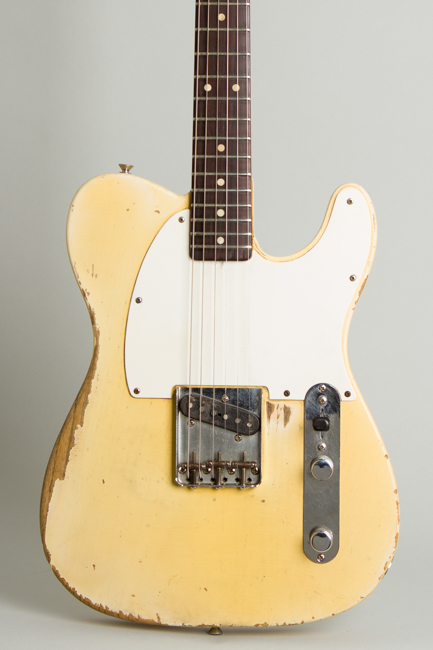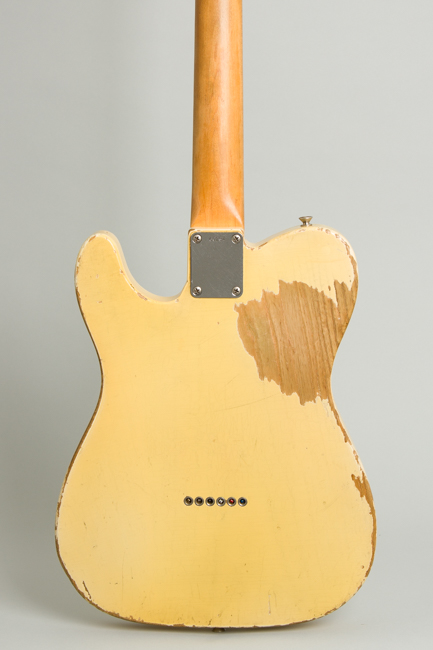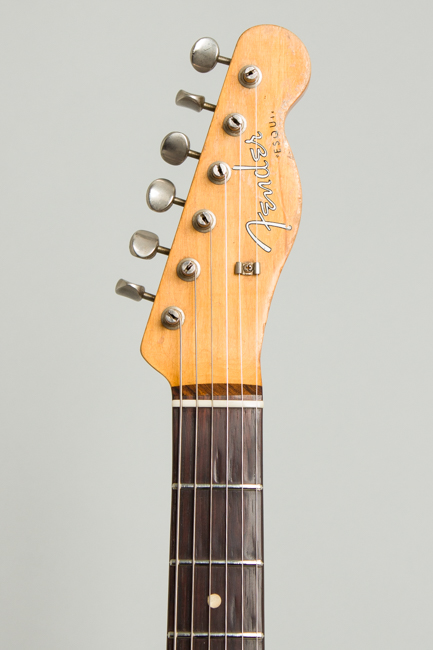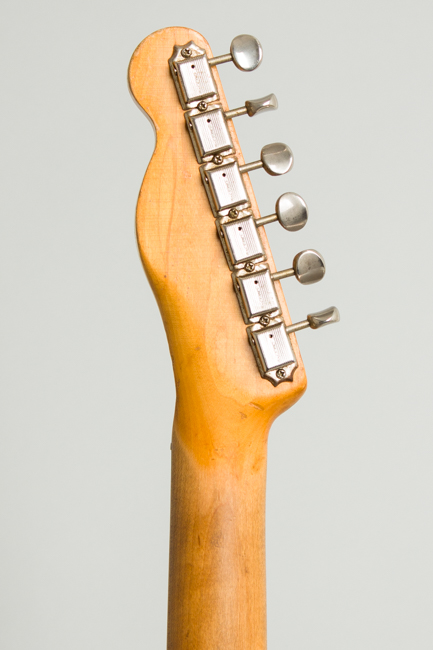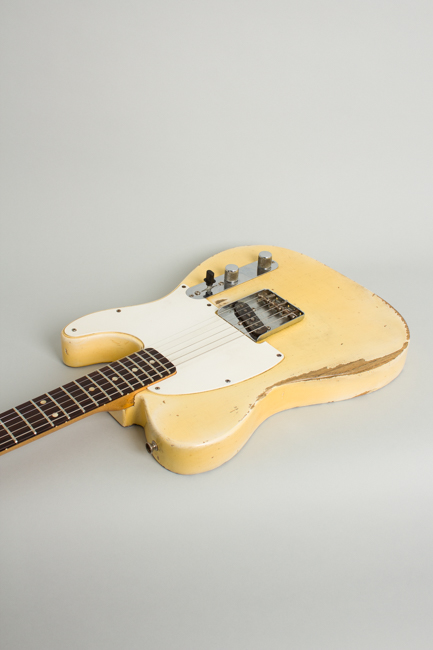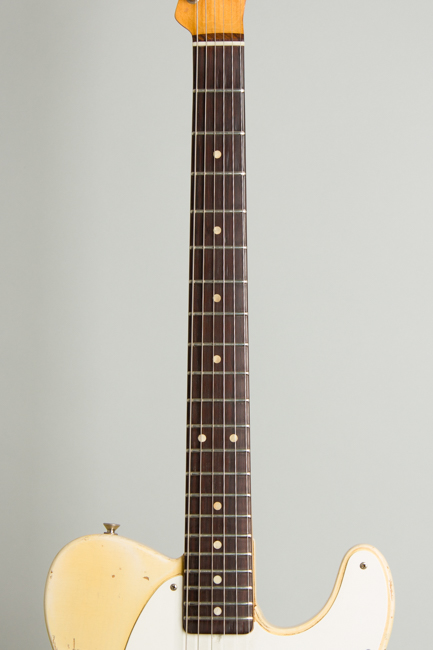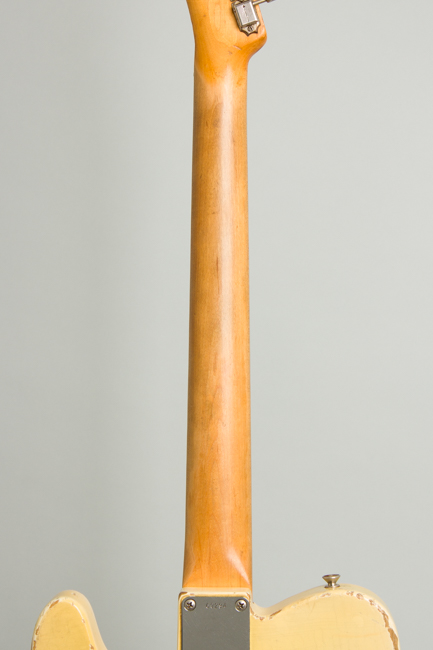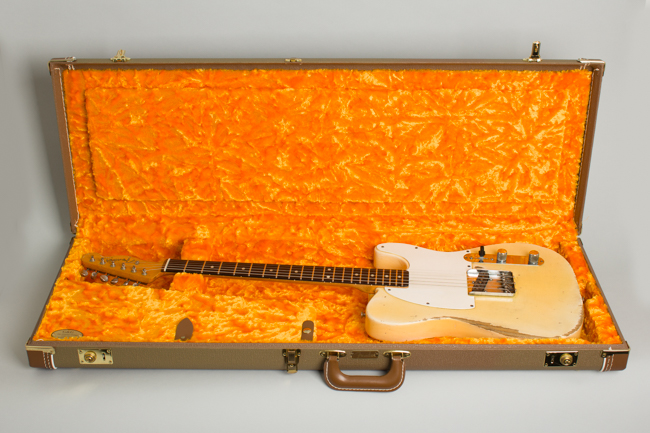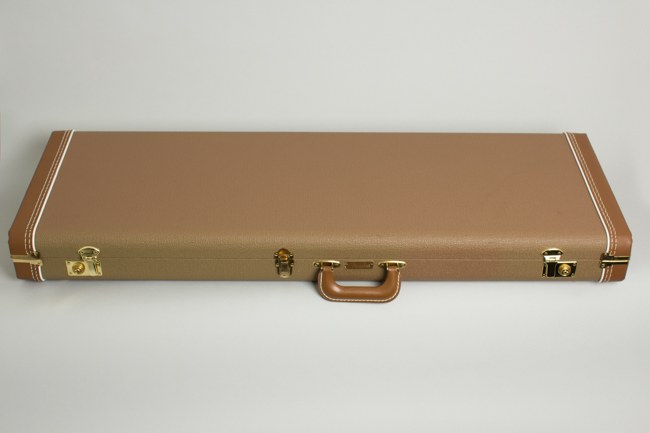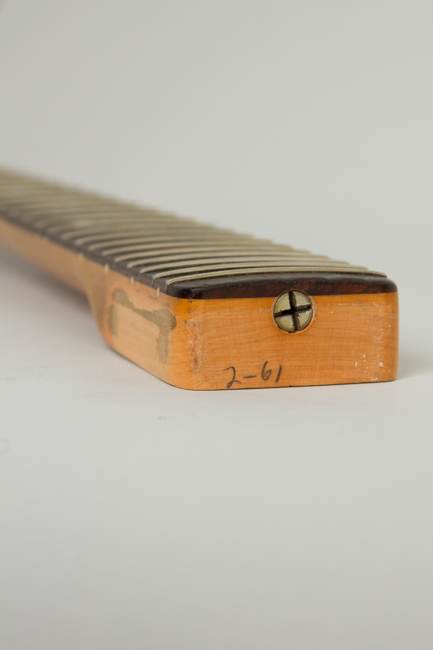Fender Esquire Solid Body Electric Guitar (1961)
Fender Esquire Model Solid Body Electric Guitar (1961), made in Fullerton, California, serial # 60294, Blonde lacquer finish, ash body, maple neck with slab rosewood fingerboard, repro brown Tolex hard shell case.
This is a worn-in but mojo-laden original example of an early 1961 "slab board" Fender Esquire, with features typical for this period. The neck is pencil dated 2-61 on the heel and the body has almost indiscernible pencil mark 1-61 in the pickup rout. The visible pot code is to the 47th week of 1960. Esquires from this period are quite rare compared to Telecasters, at the time being made in ever decreasing numbers.
The "Esquire" name had been in use at Fender since 1950 for the single pickup variation of the Broadcaster/Telecaster, by the turn of the 1960s the model's popularity was waning. While cataloged as a separate instrument, The Esquire was assembled from all the same parts as the Telecaster allowing Fender sales to offer a slightly cheaper alternative for the buyer who couldn't spring for the Tele's $189.50 price tag.
By the time this one was made sales of the Esquire were in a steep decline, outpaced by newer Fullerton models both more expensive, like the Stratocaster and Jazzmaster and especially the lower-priced Duo-Sonic and Musicmaster. Fender's introduction of these budget-priced student guitars in 1956 cut heavily into the Esquire's bottom-line sales territory, and the model began to languish. By the early-mid 1960's the Fender line had changed considerably, and the Esquire pretty much got lost in the shuffle although not officially discontinued until 1970.
Starting in the summer of 1959 the original Fender one-piece maple neck was discontinued across the line in favor of the new "slab" rosewood fingerboard with "clay' dot markers. This example has a fairly flat and slim profile in cross section typical of early slab board Fenders. The 5-digit serial number is stamped on the neck plate, and it had been since 1955. The Fender decal is the same "Spaghetti" logo script used on the Esquire for nearly its entire run, not updated until the end of the 1960s.
The body's blonde finish is somewhat thicker and more translucent than earlier blonde Fenders. It is also a more "white-blonde' hue, though this one like most has yellowed quite a bit over time. The single layer white pickguard was secured by eight screws (up from 5) another change specific to 1959. This "blank" pickguard conceals the factory rout for the neck pickup, as the bodies used were exactly the same as for the Telecaster.
The Esquire control rig is unique, although externally the same as the Telecaster with standard knurled metal volume and tone knobs and 3-way switch with a "top hat" tip. The wiring is cleverly designed to offer three tonal options on a one-pickup guitar: #1 is a special bass-heavy setting, #2 engages a normal tone control function, and #3 is a "bypass" setting sending the signal straight to the jack. This last is the Esquire's secret bonus, offering some of the finest, snarliest tones ever to emerge from Fullerton. This 1961 example has seen some fairly heavy use and shows the scars but remains an excellent playing and sounding instrument with mojo to spare.
Overall length is 38 3/4 in. (98.4 cm.), 12 3/4 in. (32.4 cm.) wide at lower bout, and 1 3/4 in. (4.4 cm.) in depth, measured at side of rim. Scale length is 25 1/2 in. (648 mm.). Width of nut is 1 5/8 in. (41 mm.)., 7.44 lbs.
This 63 year old Esquire is a "real relic" in every way showing a lot of play wear but with a killer vibe and snarling great sound. The all-original body finish has an extensive collection of dings, dents and chips, most heavily along the edges as is typical for slab-sided Teles. There is a large worn-through arm wear spot along the top edge, finger wear into the wood below the bridge and a large swath of fairly serious belt-buckle wear to the upper back.
Most of the finish is worn off worn off back of neck, giving that glorious "Worn-in Fender" feel modern relicers reach for the sandpaper attempting to emulate. Some time back the guitar was refretted with somewhat larger wire that is quite comfortable to play and a newer nut was added. The fingerboard has some light divoting in the lower positions and some "strum wear" at the body end. The "Fender" logo part of the decal is mostly intact but part of "Esquire" lettering is missing where it looks like something (a capo?) was attached to the headstock.
All hardware appears original to the guitar and shows some light corrosion, mostly to the steel bridge saddles. The guitar remains mostly original internally, having NEVER had a neck pickup fitted as was once common; the original pickguard has some typical scuffing mostly under the strings and notching by the truss rod. The single staggered-pole bridge pickup is original, the leads were spliced long ago but it does not appear to have been rewound. It WAS wax potted at some point in the distant past but arrived here quite microphonic and so has been re-potted recently by Fender whisperer Norio Imai, and snarls with the best of 'em now. The pots, switch and complex multi-capacitor Esquire wiring rig are original with largely original solder joints.
This old Esquire has survived the decades seriously played in, showing numerous scars but unaltered in any important way and ready for the next 60+ years. The sound is bright and exquisitely snarly when cranked but still sweet and bell-like when the amp is backed down. This is one pure, 7.44 Lb. package of real, genuine unadulterated vintage Fender Mojo in its simplest form. It lives in a re-issue brown Tolex case in the early '60s style. Overall Very Good + Condition.
This is a worn-in but mojo-laden original example of an early 1961 "slab board" Fender Esquire, with features typical for this period. The neck is pencil dated 2-61 on the heel and the body has almost indiscernible pencil mark 1-61 in the pickup rout. The visible pot code is to the 47th week of 1960. Esquires from this period are quite rare compared to Telecasters, at the time being made in ever decreasing numbers.
The "Esquire" name had been in use at Fender since 1950 for the single pickup variation of the Broadcaster/Telecaster, by the turn of the 1960s the model's popularity was waning. While cataloged as a separate instrument, The Esquire was assembled from all the same parts as the Telecaster allowing Fender sales to offer a slightly cheaper alternative for the buyer who couldn't spring for the Tele's $189.50 price tag.
By the time this one was made sales of the Esquire were in a steep decline, outpaced by newer Fullerton models both more expensive, like the Stratocaster and Jazzmaster and especially the lower-priced Duo-Sonic and Musicmaster. Fender's introduction of these budget-priced student guitars in 1956 cut heavily into the Esquire's bottom-line sales territory, and the model began to languish. By the early-mid 1960's the Fender line had changed considerably, and the Esquire pretty much got lost in the shuffle although not officially discontinued until 1970.
Starting in the summer of 1959 the original Fender one-piece maple neck was discontinued across the line in favor of the new "slab" rosewood fingerboard with "clay' dot markers. This example has a fairly flat and slim profile in cross section typical of early slab board Fenders. The 5-digit serial number is stamped on the neck plate, and it had been since 1955. The Fender decal is the same "Spaghetti" logo script used on the Esquire for nearly its entire run, not updated until the end of the 1960s.
The body's blonde finish is somewhat thicker and more translucent than earlier blonde Fenders. It is also a more "white-blonde' hue, though this one like most has yellowed quite a bit over time. The single layer white pickguard was secured by eight screws (up from 5) another change specific to 1959. This "blank" pickguard conceals the factory rout for the neck pickup, as the bodies used were exactly the same as for the Telecaster.
The Esquire control rig is unique, although externally the same as the Telecaster with standard knurled metal volume and tone knobs and 3-way switch with a "top hat" tip. The wiring is cleverly designed to offer three tonal options on a one-pickup guitar: #1 is a special bass-heavy setting, #2 engages a normal tone control function, and #3 is a "bypass" setting sending the signal straight to the jack. This last is the Esquire's secret bonus, offering some of the finest, snarliest tones ever to emerge from Fullerton. This 1961 example has seen some fairly heavy use and shows the scars but remains an excellent playing and sounding instrument with mojo to spare.
Overall length is 38 3/4 in. (98.4 cm.), 12 3/4 in. (32.4 cm.) wide at lower bout, and 1 3/4 in. (4.4 cm.) in depth, measured at side of rim. Scale length is 25 1/2 in. (648 mm.). Width of nut is 1 5/8 in. (41 mm.)., 7.44 lbs.
This 63 year old Esquire is a "real relic" in every way showing a lot of play wear but with a killer vibe and snarling great sound. The all-original body finish has an extensive collection of dings, dents and chips, most heavily along the edges as is typical for slab-sided Teles. There is a large worn-through arm wear spot along the top edge, finger wear into the wood below the bridge and a large swath of fairly serious belt-buckle wear to the upper back.
Most of the finish is worn off worn off back of neck, giving that glorious "Worn-in Fender" feel modern relicers reach for the sandpaper attempting to emulate. Some time back the guitar was refretted with somewhat larger wire that is quite comfortable to play and a newer nut was added. The fingerboard has some light divoting in the lower positions and some "strum wear" at the body end. The "Fender" logo part of the decal is mostly intact but part of "Esquire" lettering is missing where it looks like something (a capo?) was attached to the headstock.
All hardware appears original to the guitar and shows some light corrosion, mostly to the steel bridge saddles. The guitar remains mostly original internally, having NEVER had a neck pickup fitted as was once common; the original pickguard has some typical scuffing mostly under the strings and notching by the truss rod. The single staggered-pole bridge pickup is original, the leads were spliced long ago but it does not appear to have been rewound. It WAS wax potted at some point in the distant past but arrived here quite microphonic and so has been re-potted recently by Fender whisperer Norio Imai, and snarls with the best of 'em now. The pots, switch and complex multi-capacitor Esquire wiring rig are original with largely original solder joints.
This old Esquire has survived the decades seriously played in, showing numerous scars but unaltered in any important way and ready for the next 60+ years. The sound is bright and exquisitely snarly when cranked but still sweet and bell-like when the amp is backed down. This is one pure, 7.44 Lb. package of real, genuine unadulterated vintage Fender Mojo in its simplest form. It lives in a re-issue brown Tolex case in the early '60s style. Overall Very Good + Condition.
